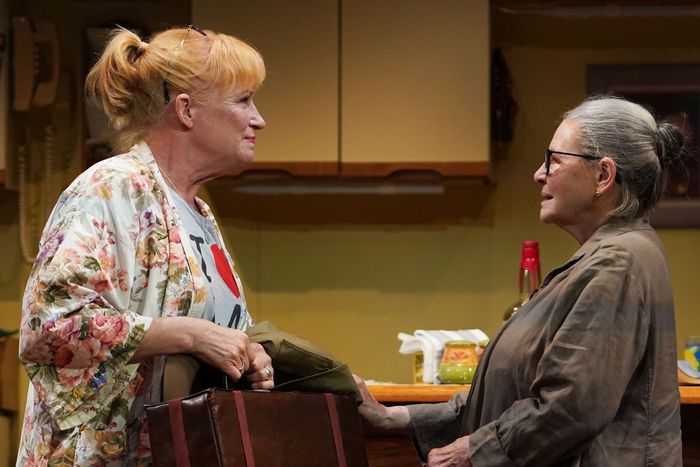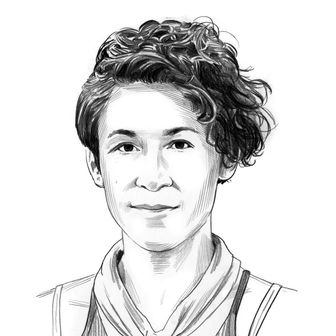
If you tried to adapt an M. C. Escher painting for the stage, you might end up with something like John J. Caswell Jr.’s Scene Partners. Its reality is fragmented, tessellated, constantly re-creating itself — it’s a house of interlocking, perspective-defying staircases, a dream hallway where it’s impossible to tell which way is up. If you happen to be someone who takes notes during plays for a living, you might find yourself writing down helpful observations such as: Okay so none of it’s real. Then, ten minutes later: JK it IS all real. Five minutes after that: … wait is it? (Like I said: helpful.)
Plenty of contemporary playwrights are interested in theatricalizing the effects of trauma, and Caswell is one of them — but he’s also clearly wary of the solemn, sentimental swamp that road can lead to. He’s aggressively searching for new dramatic shapes: “[I’m] terrified that this business we call show rests precariously upon the crumbling foundation of yesteryear,” says one of Scene Partners’ characters. So, deconstruction, ho! For Caswell, trauma shatters and scatters identity, and in response, his stage becomes both kaleidoscope and autostereogram: It can fracture narratives — reconfiguring their pieces with each turn of the apparatus — and then, if we’re able to adjust our vision, it can suddenly show us a pristine image springing from the chaos. Then we blink, and it’s gone again.
While there’s much fragmentation in Scene Partners, I wish it led to more breathtaking coalescence. Under the cool direction of Rachel Chavkin, the production never feels quite as extreme as it might. Its tone remains a bit distant, its pace a few clicks under what seems like the natural biorhythm of the play. Still, Caswell’s ambition is palpable, and we do get curiouser and curiouser. If the experience isn’t always fully rewarding, it’s consistently intriguing.
And, in Dianne Wiest, Caswell has found a spookily appropriate muse. As a performer, she’s the queen of that disconcerting middle place: Is she demure and artless, or is she going to cut you? She’s never overtly menacing, but she keeps you on edge. Scene Partners begins with a towering video of her face on the collection of LED screens that open and shut like a camera aperture across the front of Riccardo Hernández’s set. She’s coiffed and made-up, aware she’s on-camera — but when a voice-over tells her, “Whenever you’re ready, sweetheart,” there’s a flickering blankness in her expression that might be simple confusion, or animal panic, or total fugue state. Does she even know where she is, or who?
She is Meryl Kowalski, and a version of her story, with its pieces put back in order, might go like this: She was born in 1910 in Los Angeles to a father who loved her and a mother who didn’t much. “Mother left Father for a man with more money and a job in Wisconsin.” That man, Meryl’s stepfather, raped her, and neither her mother nor her stepsister, Charlize (Johanna Day), would or could acknowledge the abuse. In 1928, already pregnant, she married another abuser, “a man of Polish descent named Stanley Kowalski.” (“I have no idea who’s responsible for feeding the details of my life to Mr. Williams for his little play,” she sighs.) Her daughter, Flora (Kristen Sieh), grew up to be an addict, jobless and dependent on her, as Meryl endured years of beatings from Stanley. When we meet her, it’s 1985, “that motherfucker” is freshly deceased, and Meryl’s bags are packed for Hollywood, where she intends to become a 75-year-old movie star. “I have been acting all of my life!” she tells Flora. “It’s about time I get paid for it!”
That’s the picture — once we’ve reassembled it, and if we can trust our protagonist. Perhaps Meryl really does finagle herself an agent (Josh Hamilton), join an acting class run by a famous director (also Josh Hamilton, shape-shifting with Mephistophelean glee), and, along with that director and the help of her eager classmates (Sieh, Eric Berryman, and Carmen Herlihy), shoot a movie inspired by her own life. Or perhaps we’re living inside Meryl’s brain, irreparably damaged from Stanley’s attacks and possibly more. Perhaps all the drama, the genre play, the twists of fate and strokes of luck — the glinting slices of Meryl’s life that reflect or refract various plays and films — it’s all just a hand drawing a hand. Her mind is collapsing in on itself, fashioning a dreamworld from bits and pieces.
Or is it? Caswell keeps things slippery, right down to his title. Does Meryl have any scene partners that aren’t Meryl? But to its credit (and despite various notes one may have taken), the play never feels binary — It’s all real. / It’s all in her head. It’s more fluid than that, less interested in presenting the solution to Meryl than it is in dramatizing her multiplicity. “Is this, like, a memory play?” asks one of her acting classmates when Meryl enlists them to act in her life story. Another pipes up: “Do you want it realism or should it be more like whoa.” Meryl’s answer and Caswell’s are the same: “All of the above.” Perhaps her psyche is too scattered to be collected, or perhaps it’s too vast to be contained, or perhaps it’s a bit of both. “The story of Meryl shifts under your feet,” says Hugo, the famous director. Need Caswell have made his thesis statement explicit? Maybe not. But it certainly serves to temper our expectations: We’re going to be left hanging.
And as Meryl — who has a recurring dream about being suspended in a chairlift — knows all too well, that dangling position is sometimes exciting, sometimes frustrating. There’s certainly pleasure in the play’s continual pops of the meta and bizarre — from Meryl’s refusal, despite a certain star of Silkwood, to change her name (“Because it is my name! And I cannot have another in my life!”); to the sudden vanishing of Charlize from a recorded TV interview in which the Diane Sawyer–like anchor (Sieh, armed with wig and shoulder pads) questions the existence of Meryl’s sister; to the metamorphosing accent of Hamilton’s Hugo. “Why do you suddenly sound British?” Meryl asks him sweetly. “I thought you were Australian.” It’s a sneaky joke: Australian’s a tough accent, and we’ve been tempted to hear the switch as an actor’s mistake, but as always, the play is fanning the flames of our mistrust and then dousing them again. “Meryl,” says Hugo, with a matinee-idol smile, “you know better than anyone. We are everything and anything.”
It’s beguiling — and at the same time, there’s a bag-of-tricks quality to Scene Partners. It’s a play of turns that never quite builds to The Prestige. It may in part be a staging matter: While the show is a mash-up of genres and styles — we get Russian romance à la Doctor Zhivago, tough-talking noir, Lynchian dreamscape, and sunny 1980s sitcom — Chavkin and her designers could push all of these episodes further, render their colors more vivid, their contours more gorgeous and grotesque. Behind its fancy screens, Hernández’s set is wide, shallow, and mostly bare, and Meryl’s epic tale is fashioned out of scrappy items from the acting class — folding chairs and gaffer tape. There’s something endearing about this, but it’s diminishing, too. When the ground shifts under our feet, its vibrations are apt to diffuse.
“Is that what bothers you?” Meryl asks Sieh’s arch anchorwoman. “Not being on solid ground?” It’s a playwright’s little dig at the audience, but, at least for me, the answer is No, that’s not quite it. I don’t need to feel certain, but I do want to feel more than ambivalent. If Caswell’s play is a kind of explosion — a bundle of TNT hooked up to an intricate Jenga tower of tropes, aesthetics, references, memories, fantasies, dramatic structures, and dreams — then I want to be hit by the blast. As it is, Scene Partners tantalizes, ultimately leaving the brain buzzier than the body. We’re interested, but we’re left craving astonishment.
Scene Partners is at the Vineyard Theatre through December 17.


